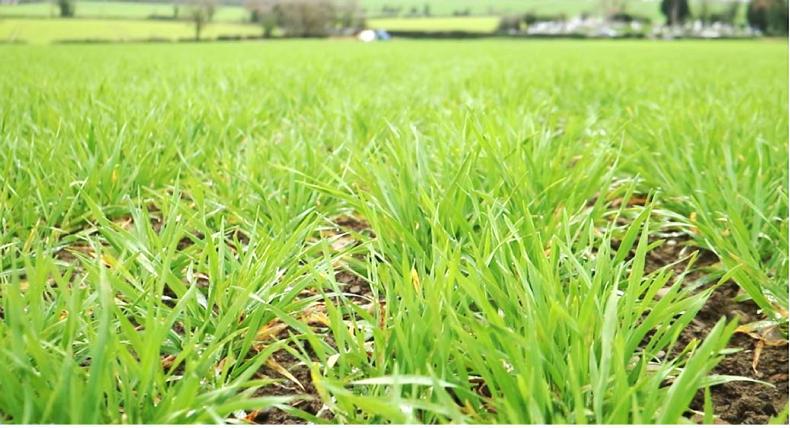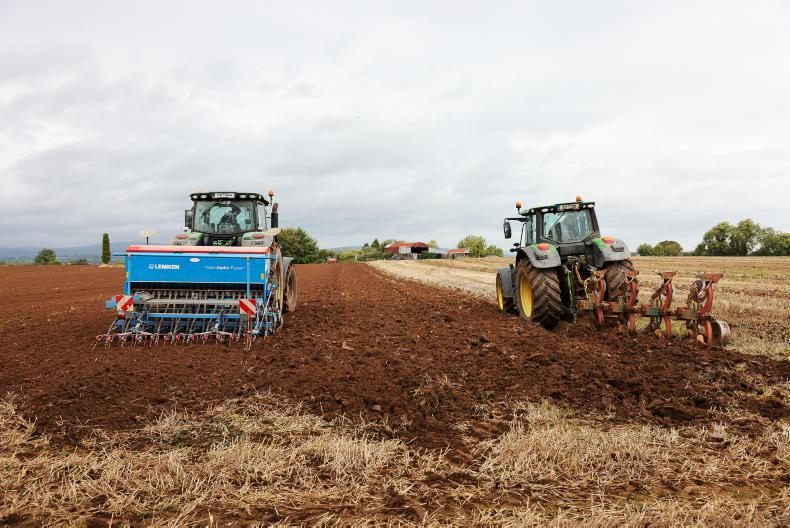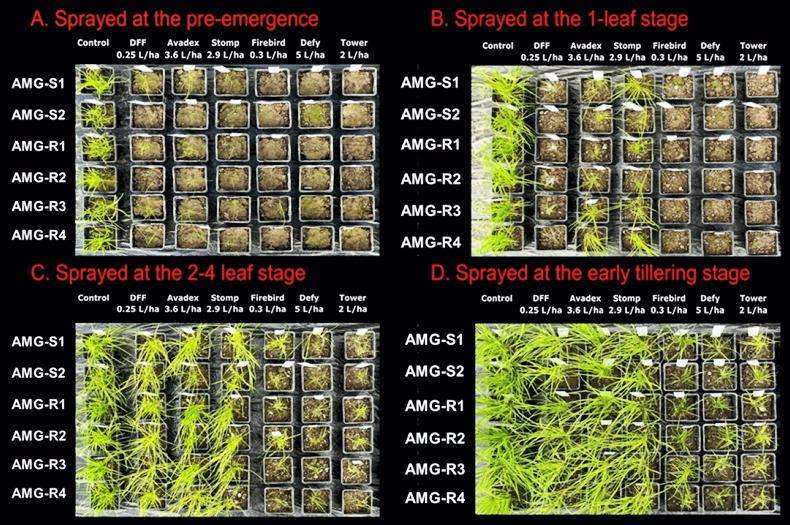
Athy,
Co Kildare
Despite the broken weather, drying winds have allowed some amount of field work to take place over the past few weeks in Athy. As discussed in last season’s From the Tramlines, Andrew’s winter crops were sown in ideal conditions. He runs a no-till system, drilling directly into desiccated cover crops, many of which consist of leguminous nitrogen-fixing species.
His winter crops got off to a flying start. This year he’s growing Cassia winter barley for seed. Last year the crop received a post-emergence herbicide application of Vigon (0.5l/ha) and DFF (0.15l/ha). He’s also growing the early winter wheat variety Cellule. “I think the early variety suits early ground like this,” he says. The crop received a pre-emergence spray of Firebird (0.3l/ha) and Vigon (0.5l/ha). The crop is currently heading for GS31, but growth has been limited over the past few weeks. He’s also growing Husky winter oats for seed and the crop received a pre-emergence spray of DFF (0.25l/ha). It will receive a follow-up herbicide in the spring. His winter oats and winter wheat received 400kg/ha of chicken manure pellets at the end of September.

Andrew's Planet spring malting barley looked perished as it emerged last week.
Early spring work
The good weather in February allowed for some early groundwork. Andrew has been flailing all of his cover crops this spring in order to avoid issues with green cover trailing on the legs of his drill.
This happened a number times in the autumn. He sowed around 20ha of Planet malting barley for Boortmalt, the seed of which was manganese treated. It was sown at 165kg/ha and had a TGW of 50g, aiming for a minimum 85% emergence. He applied 125kg/ha of CAN last week and is aiming to make distilling grade.
All of the winter crops received 100kg/ha of Polysulfate. At the start of March, Andrew applied 280 kg/ha of 10:10:20 on his winter barley, which was sown in index 2 soils for P.
He also applied 570kg/ha of chicken manure pellets on his winter barley ground. Around 200kg/ha of 10:10:20 was applied on his winter wheat, oats and spring barley around 7 March.

Bushmills,
Co Antrim
From fantastic weather in February to windy, wet conditions in March — the weather in one of the most northerly tillage regions on the island has been pretty similar to the rest of the country. Mark sowed California winter barley around 20 September last year, following potatoes. With potatoes in the rotation, he runs a plough-based system using two Kverneland four-furrow ploughs on no.8 boards. He generally ploughs at 16in furrows. He drills directly into ploughed ground with his 3m Sulky box drill. As field conditions were good last year, he rolled everything with his Cambridge roller. His seed was dressed with a standard dressing but as BYDV isn’t a particular issue with him, he doesn’t use Redigo Deter. His crops received a post-emergence herbicide application of Crystal (3.3l/ha) and DFS (0.2l/ha). He will assess these crops in the coming weeks to see if they need a follow-up spring herbicide to knock out potato volunteers.

Mark destoning ground ahead of planting chitted potato seed in February.
Washing and packing
Potatoes are graded and moved from ambient stores to fridges for storage at 3°C in January and February. Supplies of potatoes in refrigerated storage should last until around August. He also washes and packs potatoes every weekday and delivers product six days a week. He delivers potatoes to shops within an 80km radius. Mark started planting early Queens and Homeguard potatoes around 20 February, the earliest in years. Ground was ploughed, ridged, bed-tilled and destoned before planting on 74in beds. All of his early seed was first chitted in a dedicated chitting store before being planted with a standen planter. Planting chitted seed is a much slower process in order to be gentle with the seed. The crop was sown with 875kg/ha of 8:10:20 plus sulphur.
Most of Mark’s spring cereal ground is now ploughed, as is an amount of his potato ground. He intends to spread some nitrogen on his winter crops in the coming week.

Ballyragget,
Co Kilkenny
Each season, James makes a budget for all costs associated with growing his crops. So far this year he’s slightly below budget due to a downward revision of N rates, as crops are so advanced.
Excellent conditions last autumn meant that sowing was largely finished by 15 October. Generally straw is removed with a bale chaser and the ground is cultivated immediately after with a 5m Horsch Tiger cultivator with a double-D press. Cultivating 4-6in deep, he pulls this with a Fendt 939.
This is left up to six weeks during which he could burn the weeds and volunteers one to two times. He drills with a 6m Horsch Sprinter and places 100kg/ha with the seed. His P indices have been rising over the past seven years. All the seed was treated with Redigo Deter while the barley was treated with Latitude. His wheat and barley received an aphicide six to eight weeks post-drilling. Jame’s winter crop weed control strategy is to roll and pre-emergence, even if it means he has to stop sowing. This year he’s growing Quadra and Belfry winter barley which received a pre-emergence herbicide of Vigon (0.5l/ha) and DFF (0.2l/ha). Around three weeks ago they received 44kg/ha of SulCAN. All crops received between 160kg and 250kg of 0:0:50 in January as ground conditions were excellent.

James spreading 465kg/ha of SulCAN (27% N) plus sulphur (4%) with his Fendt 939.
He’s growing JB Diego, Costello and a small amount of Graham. Most of the crops were pre-emerged with Vigon (0.8l.ha) and DFF (0.2l/ha). His wheat after oats and seed crops received Pacifica Plus (300g/ha) in February. He’s growing Husky oats this season but they are a little too advanced for the time of year. They received DFF (0.25l/ha) pre-emergence and three weeks ago they received 70kg/ha of SulCAN.
This year he’s growing Extrovert and a small amount of Aquila winter oilseed rape. As sowing conditions were so good, his sowing rate was 1.7kg/ha aiming for 25 plants/m2 in spring. The crop received Katamaran turbo (1.5l/ha) pre-emergence and Stratos Ultra (1.25l/ha) where volunteers were present. It also received Kerb Flo (1.5-2l/ha) and Proline (0.3l/ha) in January. 60% of the crop also received Caramba (0.6l/ha) in February.
Read more
From the tramlines: spring ground work at a standstill
Watch: From the tramlines returns for 2019

Athy,
Co Kildare
Despite the broken weather, drying winds have allowed some amount of field work to take place over the past few weeks in Athy. As discussed in last season’s From the Tramlines, Andrew’s winter crops were sown in ideal conditions. He runs a no-till system, drilling directly into desiccated cover crops, many of which consist of leguminous nitrogen-fixing species.
His winter crops got off to a flying start. This year he’s growing Cassia winter barley for seed. Last year the crop received a post-emergence herbicide application of Vigon (0.5l/ha) and DFF (0.15l/ha). He’s also growing the early winter wheat variety Cellule. “I think the early variety suits early ground like this,” he says. The crop received a pre-emergence spray of Firebird (0.3l/ha) and Vigon (0.5l/ha). The crop is currently heading for GS31, but growth has been limited over the past few weeks. He’s also growing Husky winter oats for seed and the crop received a pre-emergence spray of DFF (0.25l/ha). It will receive a follow-up herbicide in the spring. His winter oats and winter wheat received 400kg/ha of chicken manure pellets at the end of September.

Andrew's Planet spring malting barley looked perished as it emerged last week.
Early spring work
The good weather in February allowed for some early groundwork. Andrew has been flailing all of his cover crops this spring in order to avoid issues with green cover trailing on the legs of his drill.
This happened a number times in the autumn. He sowed around 20ha of Planet malting barley for Boortmalt, the seed of which was manganese treated. It was sown at 165kg/ha and had a TGW of 50g, aiming for a minimum 85% emergence. He applied 125kg/ha of CAN last week and is aiming to make distilling grade.
All of the winter crops received 100kg/ha of Polysulfate. At the start of March, Andrew applied 280 kg/ha of 10:10:20 on his winter barley, which was sown in index 2 soils for P.
He also applied 570kg/ha of chicken manure pellets on his winter barley ground. Around 200kg/ha of 10:10:20 was applied on his winter wheat, oats and spring barley around 7 March.

Bushmills,
Co Antrim
From fantastic weather in February to windy, wet conditions in March — the weather in one of the most northerly tillage regions on the island has been pretty similar to the rest of the country. Mark sowed California winter barley around 20 September last year, following potatoes. With potatoes in the rotation, he runs a plough-based system using two Kverneland four-furrow ploughs on no.8 boards. He generally ploughs at 16in furrows. He drills directly into ploughed ground with his 3m Sulky box drill. As field conditions were good last year, he rolled everything with his Cambridge roller. His seed was dressed with a standard dressing but as BYDV isn’t a particular issue with him, he doesn’t use Redigo Deter. His crops received a post-emergence herbicide application of Crystal (3.3l/ha) and DFS (0.2l/ha). He will assess these crops in the coming weeks to see if they need a follow-up spring herbicide to knock out potato volunteers.

Mark destoning ground ahead of planting chitted potato seed in February.
Washing and packing
Potatoes are graded and moved from ambient stores to fridges for storage at 3°C in January and February. Supplies of potatoes in refrigerated storage should last until around August. He also washes and packs potatoes every weekday and delivers product six days a week. He delivers potatoes to shops within an 80km radius. Mark started planting early Queens and Homeguard potatoes around 20 February, the earliest in years. Ground was ploughed, ridged, bed-tilled and destoned before planting on 74in beds. All of his early seed was first chitted in a dedicated chitting store before being planted with a standen planter. Planting chitted seed is a much slower process in order to be gentle with the seed. The crop was sown with 875kg/ha of 8:10:20 plus sulphur.
Most of Mark’s spring cereal ground is now ploughed, as is an amount of his potato ground. He intends to spread some nitrogen on his winter crops in the coming week.

Ballyragget,
Co Kilkenny
Each season, James makes a budget for all costs associated with growing his crops. So far this year he’s slightly below budget due to a downward revision of N rates, as crops are so advanced.
Excellent conditions last autumn meant that sowing was largely finished by 15 October. Generally straw is removed with a bale chaser and the ground is cultivated immediately after with a 5m Horsch Tiger cultivator with a double-D press. Cultivating 4-6in deep, he pulls this with a Fendt 939.
This is left up to six weeks during which he could burn the weeds and volunteers one to two times. He drills with a 6m Horsch Sprinter and places 100kg/ha with the seed. His P indices have been rising over the past seven years. All the seed was treated with Redigo Deter while the barley was treated with Latitude. His wheat and barley received an aphicide six to eight weeks post-drilling. Jame’s winter crop weed control strategy is to roll and pre-emergence, even if it means he has to stop sowing. This year he’s growing Quadra and Belfry winter barley which received a pre-emergence herbicide of Vigon (0.5l/ha) and DFF (0.2l/ha). Around three weeks ago they received 44kg/ha of SulCAN. All crops received between 160kg and 250kg of 0:0:50 in January as ground conditions were excellent.

James spreading 465kg/ha of SulCAN (27% N) plus sulphur (4%) with his Fendt 939.
He’s growing JB Diego, Costello and a small amount of Graham. Most of the crops were pre-emerged with Vigon (0.8l.ha) and DFF (0.2l/ha). His wheat after oats and seed crops received Pacifica Plus (300g/ha) in February. He’s growing Husky oats this season but they are a little too advanced for the time of year. They received DFF (0.25l/ha) pre-emergence and three weeks ago they received 70kg/ha of SulCAN.
This year he’s growing Extrovert and a small amount of Aquila winter oilseed rape. As sowing conditions were so good, his sowing rate was 1.7kg/ha aiming for 25 plants/m2 in spring. The crop received Katamaran turbo (1.5l/ha) pre-emergence and Stratos Ultra (1.25l/ha) where volunteers were present. It also received Kerb Flo (1.5-2l/ha) and Proline (0.3l/ha) in January. 60% of the crop also received Caramba (0.6l/ha) in February.
Read more
From the tramlines: spring ground work at a standstill
Watch: From the tramlines returns for 2019















SHARING OPTIONS